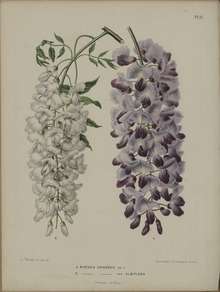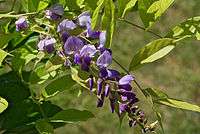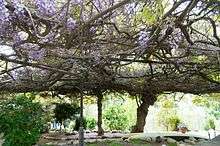Wisteria sinensis
| Wisteria sinensis | |
|---|---|
| Scientific classification | |
| Kingdom: | Plantae |
| (unranked): | Angiosperms |
| (unranked): | Eudicots |
| (unranked): | Rosids |
| Order: | Fabales |
| Family: | Fabaceae |
| Subfamily: | Faboideae |
| Genus: | Wisteria |
| Species: | W. sinensis |
| Binomial name | |
| Wisteria sinensis | |

Wisteria sinensis (Chinese wisteria) is a woody, deciduous, perennial climbing vine in the genus Wisteria, native to China in the provinces of Guangxi, Guizhou, Hebei, Henan, Hubei, Shaanxi, and Yunnan. While this plant is a climbing vine, it can be trained into a tree-like shape, usually with a wavy trunk and a flattened top.
It can grow 20–30 m long over supporting trees by counterclockwise-twining stems. The leaves are shiny, green, pinnately compound, 10–30 cm in length, with 9-13 oblong leaflets that are each 2–6 cm long. The flowers are white, violet, or blue, produced on 15–20 cm racemes before the leaves emerge in spring. The flowers on each raceme open simultaneously before the foliage has expanded, and have a distinctive fragrance similar to that of grapes. Though it has shorter racemes than Wisteria floribunda (Japanese wisteria), it often has a higher quantity of racemes. The fruit is a flattened, brown, velvety, bean-like pod 5–10 cm long with thick disk-like seeds around 1 cm in diameter spaced evenly inside; they mature in summer and crack and twist open to release the seeds; the empty pods often persist until winter. However seed production is often low, and most regenerative growth occurs through layering and suckering.
It is hardy in USDA plant hardiness zones 5-9, and prefers moist soils. It is considered shade tolerant, but will flower only when exposed to partial or full sun. It will also flower only after passing from juvenile to adult stage, a transition that may take up to 20 years. It can live for over a hundred years.
All parts of the plant contain a glycoside called wisterin which is toxic if ingested and may cause nausea, vomiting, stomach pains, and diarrhea. Wisterias have caused poisoning in children of many countries, producing mild to severe gastroenteritis.
Wisteria sinensis has secured for itself a place as one of the most popular vines for home gardens due to its flowering. It has however become an invasive species in some areas of the eastern United States[1] where the climate closely matches that of China.
A one-acre (4,000 m2) specimen located in Sierra Madre, California is recognized by Guinness World Records as the world's largest blossoming plant.[2]
Cultivation and history
Wisteria sinensis was unknown in Europe before 1816, when several agents of the East India Company working in China sent cuttings back to England.[3] A 200 year-old vine, growing at Griffin's Brewery in Chiswick, London, planted that same year, is often cited as England's oldest living wisteria plant.[4][5] Over the next several decades the plant became, and remains, one of the quintessential ornamental vines in English gardens. The white-flowering form, Wisteria sinensis 'Alba', was discovered in a garden by Botanist Robert Fortune in 1844, from whence he took cuttings for the Royal Horticultural Society.[6] It is most commonly trained along garden walls, along the exterior of buildings, or over a pergola to create avenues of overhanging blossoms during bloom.
Chinese Wisteria is more sensitive to cold than American Wisteria (Wisteria frutescens) and Japanese Wisteria (Wisteria floribunda). Although root hardy to USDA Zone 5 (-20 Fahrenheit), the vine can suffer serious dieback during such cold snaps. Moreover the frequency of spring frosts in Zones 5 and 6 can kill latent flower buds, so that the plant might only bloom sporadically.
In addition to the white 'Alba', 'Prolific' features the classic purple flowers, but in greater abundance with larger racemes. It also blooms at an earlier age than the traditional cultivar, decreasing wait time for the average home gardener.[7] The variety 'Amethyst' has deeper colored reddish violet flowers that are extremely fragrant.[8]
Gallery
 Raceme and leaves of Chinese wisteria, in a garden, France.
Raceme and leaves of Chinese wisteria, in a garden, France. Season-impression animation of a free standing Wisteria sinensis at the Tsubo-en Zen garden
Season-impression animation of a free standing Wisteria sinensis at the Tsubo-en Zen garden Wisteria sinensis as a weed in South Carolina, U.S.A.
Wisteria sinensis as a weed in South Carolina, U.S.A. The Sierra Madre Wistaria (the preferred spelling)
The Sierra Madre Wistaria (the preferred spelling)
References
- ↑ "Wisteria sinensis (Sims) DC". Natural Resources Conservation Service, United States Department of Agriculture. Retrieved December 13, 2014.
- ↑ Palma, Claudia (March 10, 2016). What to know if you're heading to Sierra Madre's Wistaria Festival. Retrieved August 21, 2016.
- ↑ "Wisteria..." Parks & Gardens UK. 2014-02-08. Retrieved 2017-06-05.
- ↑ "Battle to save historic wisteria (From Your Local Guardian)". Yourlocalguardian.co.uk. Retrieved 2015-07-30.
- ↑ "The oldest wisteria in England". www.fullers.co.uk. 2015-05-06. Retrieved 2017-06-05.
- ↑ "Wisteria..." Parks & Gardens UK. 2014-02-08. Retrieved 2017-06-05.
- ↑ "Wisteria sinensi 'Prolific'". Missouribotanicalgarden.org. Retrieved 2017-11-29.
- ↑ Peter., Valder, (1995). Wisterias : a comprehensive guide. Portland, Or.: Timber Press. ISBN 0881923184. OCLC 32647814.
Further reading
Jiang, Yifan; Chen, Xinlu; Lin, Hong (2011). "Floral Scent in Wisteria: Chemical Composition, Emission Pattern, and Regulation". Journal of the American Society for Horticultural Science. 136 (5): 307–314.
Zhang, Shu-yong; Xia, Jiang-bao; Zhou, Ze-fu; Zhang, Guang-can (September 2007). "Photosynthesis responses to various soil moisture in leaves of Wisteria sinensis". Journal of Forestry Research. 18 (3): 217–220. doi:10.1007/s11676-007-0044-6.
External links
| Wikimedia Commons has media related to Wisteria sinensis. |